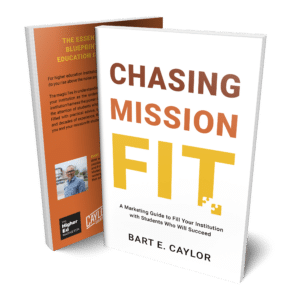Scaling AI Fluency for Marketing Teams: How ASU Leads with Innovation and Intent
See how ASU is leading AI fluency for marketing teams through leadership buy-in, innovation challenges, and custom tools that drive real, campus-wide impact.
social media
To get the most out of every dollar, higher ed marketers need to follow best practices for PPC and digital marketing.
In today’s fast-paced world, staying ahead of digital trends is crucial.
Besides that, higher ed marketing is not a one-size-fits-all endeavor.
Each institution is unique and can’t be all things for all people.
Finding what consistently works for your brand in terms of messaging as well as tactical strategies — and sticking to it! — is crucial to brand growth.
The first steps toward success are removing personal bias, having a goal, and understanding that it requires investment.

As you’ll see here, Jay’s pragmatic approach provides invaluable insights for higher education institutions looking to optimize their marketing efforts.
Digital literacy goes beyond knowing how to use various platforms; it’s about understanding how to leverage these tools effectively.
Jay emphasizes the importance of asking the right questions and understanding what each platform can deliver for your institution.
When higher ed goes out and buys [PPC campaigns] for programs, [they don’t really buy with] knowledge. [It’s more like] “give me the shiny thing, but I don’t really know what it is.”
You say, “I got Facebook, and I got all these platforms!” Ok, so how do they tie into your marketing? “I don’t know, but I got them! We’re on every single platform.”
[However], in the marketing space, you don’t need to be on every single platform. That’s not a wise decision.
You really need to understand what you’re buying, and what you don’t get from buying.
Unfortunately, many schools buy into the latest shiny object without fully understanding its impact.
It’s crucial to know what you’re buying and how it fits into your overall strategy.
Jay underscores the importance of focusing on meaningful metrics rather than vanity metrics.
He advises schools to prioritize metrics like the number of qualified leads and conversions over less impactful data points.
A lot of folks are still concerned about metrics that just do not matter.
[For example, cost per lead] is not a metric worth measuring when it comes to the end goal of what you’re trying to do.
Try to get qualified people in the door, by whatever means. If it costs $30 or $40 to get a qualified person, then okay. That’s what it costs.
But you have to measure what makes sense.
When people say, “I just want 100 leads for $7.” Why?
So you want 100 leads [in order to] waste your enrollment team’s time on bad leads? You’re just constantly shooting yourself in the foot.
In other words, it’s not about how many clicks you get; it’s about how many qualified people you talk to.
Qualified leads are what truly matter in achieving your enrollment goals, even if that means you have to pay a little more per click.
Selecting the appropriate platforms is vital for reaching your target audience.
Jay highlights the importance of understanding your audience and choosing platforms that align with their behaviors.
For instance, while TikTok and Snapchat may be suitable for engaging younger audiences, LinkedIn might be more effective for targeting MBA candidates.
Jay advises that higher ed marketers talk to the people who interact with prospective students.
Their insights can guide you to the right platforms.
Now, we arrive at the money section of our talk on best practices for PPC campaigns.
Budget is a common concern for higher education marketers.
Jay suggests a strategic approach to budget allocation, emphasizing the need to invest in platforms that offer the best return on investment.
[You need to understand that] it will cost you some money.
If you have a goal of 40 [enrollments] that’s the ultimate goal. And if your budget per month [on ad spend] is $2,000, [then that will be] difficult.
The rule of thumb in any business [is to budget] 20% of your revenues for marketing.
If you don’t have a lot of money, you can’t really do many brand awareness campaigns, and you can’t really do reach campaigns.
You have to do the best with your message and [work] to get them on the first try.
[Also,] you [need to] find one or two channels to place your ads on. So you find a channel where you can reach the most amount of people for the least amount of money and try to optimize that to squeeze as much as possible.
When talking about best practices for PPC campaigns, you’ve got to begin by understanding your ultimate goals and from there allocate your budget accordingly.
Sometimes, less is more if you focus your efforts on the most effective channels.
Personal biases can significantly impact marketing decisions.
In the conversation, Jay shares a story about a school that wanted to divest from Meta due to perceived ethical concerns, which ultimately led to wasted resources on less effective platforms.
Here’s the thing: you have a goal to reach. You have to reach your goal. This noble cause you have [about your preferences of social media], it’s going to hurt your goal.
[Some brands] left Twitter because of what Elon said. But those big brands can afford to do it! Disney can do whatever it wants. They can leave. It doesn’t matter.
[But] you’re a school who has a small amount of budget. It doesn’t matter what you like [about a certain platform], you have to go where your audience is.
[When it comes to best practices for PPC], the number one thing holding higher education back is personal bias. The people in the higher up’s are just making decisions based off what they don’t like, even though the data says something differently.
You have to separate personal bias from business decisions.
Focus on what works best for reaching your goals, even if it’s not your personal preference.
This is the last item of our list of best practices for PPC because data is the backbone of informed marketing decisions.
Jay highlights the importance of using data to guide your strategy and make adjustments based on performance.
Data is everything. You have to have data to make informed decisions.
Now what type of data [you need to track] is a whole other conversation. [You need to be] looking at the right things, the things that matter.
[For example,] it doesn’t matter how many hits we got to a website. So, we have people hit a website through whatever channel. [But] are they sticking around? Are they bouncing? Is there a tool that could measure against the landing page like hotjar?
These are metrics that matter that can help you formulate your plan going forward.
You can’t make changes based off opinions. That’s a no-no.
Data helps you understand what’s working and what needs to change. It’s all about making informed decisions to optimize your marketing efforts.
Some of the most important metrics to track:
Enhancing digital literacy is essential for higher education marketers aiming to stay competitive.
By understanding key metrics, choosing the right platforms, and making data-driven decisions, institutions can significantly improve their marketing outcomes.
Jay Rathell’s insights provide a valuable roadmap for navigating the complex landscape of digital marketing in higher education.
For more insights on optimizing your higher education marketing strategies, listen to the full interview with Jay Rathell on The Higher Ed Marketer podcast.
If you’re looking to elevate your institution’s digital literacy and marketing effectiveness, reach out to Caylor Solutions to learn about our social media strategy planning and management packages.
The essential marketing book every higher education institution needs! If you are a higher education marketing professional seeking a fail-safe plan to make your institution stand out, “Chasing Mission Fit” is your guide.

So you can empower your institution with audience-focused marketing strategies, and attract mission-fit students who will flourish in your unique academic environment.
Ready to transform your institution’s marketing approach?
Order now!
Featured image by NicoElNino via Adobe Stock
Subscribe to The Higher Ed Marketer podcast today!